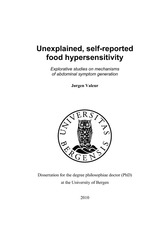Unexplained, self-reported food hypersensitivity. Explorative studies on mechanisms of abdominal symptom generation
Doctoral thesis

Permanent lenke
https://hdl.handle.net/1956/4295Utgivelsesdato
2010-10-08Metadata
Vis full innførselSamlinger
Sammendrag
Background: Self-reported food hypersensitivity remains unexplained in most cases. Abdominal symptoms, typically consistent with the irritable bowel syndrome (IBS), are common in patients with such unexplained, self-reported food hypersensitivity. The etiology is obscure. Aim: The overall objective of the present study was to investigate possible mechanisms of postprandial abdominal symptom generation. A main purpose was to explore whether and how ingestion of low-digestible carbohydrates act as abdominal symptom triggers in patients with unexplained, self-reported food hypersensitivity. Main results: The findings can be summarized as follows: In study I, fructose-sorbitol malabsorption evoked more symptoms in patients with unexplained, self-reported food hypersensitivity than in healthy controls. Alterations in intestinal gas production and secretion of so-called ileal brake hormones (glucagon-like peptide 1 (GLP-1) and peptide YY (PYY)) could not be demonstrated. In study II, serum levels of chromogranin A (CgA) were found to be lower in patients with unexplained, self-reported food hypersensitivity than in healthy controls. In study III, lactulose malabsorption evoked more symptoms in patients with unexplained, self-reported food hypersensitivity than in healthy controls. The symptoms could not be fully explained by symptom anticipation, because lactulose induced more symptoms than placebo (glucose). Associated alterations in intestinal gas production and rectal levels of prostaglandin E2 (PGE2) and microbial fermentation products could not be demonstrated. In study IV, mechanisms of diarrhoea in a mouse model of food allergy were investigated. Changes within the jejunum were demonstrated in the food allergic mice, with development of muscular hypocontractility, increased levels of cytokines IL-4 and IL-6 and high numbers of mast cells. In study V, fecal levels of short-chain fatty acids (SCFA) were investigated, and the profile was different between patients with unexplained, self-reported food hypersensitivity and healthy controls. Increased proportions of butyric acid were demonstrated in the patient group, particularly in individuals with severe symptoms. Conclusion: Taken together, the results suggest that intolerance to low-digestible carbohydrates plays an important role in abdominal symptom generation in patients with unexplained, self-reported food hypersensitivity. Disturbances of intestinal motility may contribute to gastrointestinal symptom development by increasing the amount of malabsorbed carbohydrates. Altered intestinal fermentation is a potential cause of the patients’ unexplained symptoms.
Består av
Paper I: Scandinavian Journal of Gastroenterology 43(10), Valeur, J.; Øines, E.; Morken, M. H.; Holst, J. J.; Berstad, A., Plasma glucagon-like peptide 1 and peptide YY levels are not altered in symptomatic fructose-sorbitol malabsorption, pp. 1212-1218. Copyright 2008 Informa UK. Full text not available in BORA due to publisher restrictions. The published version is available at: http://dx.doi.org/10.1080/00365520802116448Paper II: Scandinavian Journal of Gastroenterology 43(11), Valeur, J.; Milde, A. M.; Helle, K. B.; Berstad, A., Low serum chromogranin A in patients with self-reported food hypersensitivity, pp. 1403-1404. Copyright 2008 Informa UK. Full text not available in BORA due to publisher restrictions. The published version is available at: http://dx.doi.org/10.1080/00365520802273074
Paper III: Scandinavian Journal of Gastroenterology 44(12), Valeur, J.; Morken, M. H.; Norin, E.; Midtvedt, T.; Berstad, A., Carbohydrate intolerance in patients with self-reported food hypersensitivity: comparison of lactulose and glucose, pp. 1416-1423. Copyright 2009 Informa UK. Full text not available in BORA due to publisher restrictions. The published version is available at: http://dx.doi.org/10.3109/00365520903348684
Paper IV: BMC Gastroenterology 9(33), Valeur, J.; Lappalainen, J.; Rita, H.; Lin, A. H.; Kovanen, P. T.; Berstad, A.; Eklund, K. K.; Vaali, K., Food allergy alters jejunal circular muscle contractility and induces local inflammatory cytokine expression in a mouse model. Copyright 2009 Valeur et al; licensee BioMed Central Ltd. Reproduced with permission. Published version. The published version is also available at: http://dx.doi.org/10.1186/1471-230X-9-33
Paper V: Clinical and Experimental Gastroenterology 3, Valeur, J.; Morken, M. H.; Norin, E.; Midtvedt, T.; Berstad, A., Intestinal fermentation in patients with self-reported food hypersensitivity: painful, but protective?, pp. 65-70. Copyright 2010 Valeur et al, publisher and licensee Dove Medical Press. Reproduced with permission. Published version. The published version is also available at: http://dx.doi.org/10.2147/CEG.S11349
Utgiver
The University of BergenOpphavsrett
Copyright the author. All rights reservedThe author